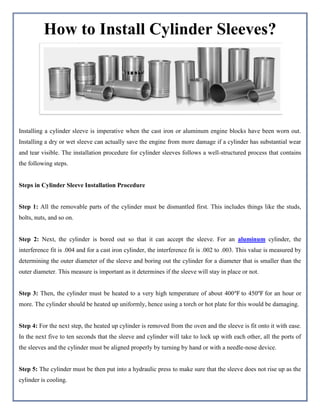How to install cylinder sleeves
- 1. How to Install Cylinder Sleeves? Installing a cylinder sleeve is imperative when the cast iron or aluminum engine blocks have been worn out. Installing a dry or wet sleeve can actually save the engine from more damage if a cylinder has substantial wear and tear visible. The installation procedure for cylinder sleeves follows a well-structured process that contains the following steps. Steps in Cylinder Sleeve Installation Procedure Step 1: All the removable parts of the cylinder must be dismantled first. This includes things like the studs, bolts, nuts, and so on. Step 2: Next, the cylinder is bored out so that it can accept the sleeve. For an aluminum cylinder, the interference fit is .004 and for a cast iron cylinder, the interference fit is .002 to .003. This value is measured by determining the outer diameter of the sleeve and boring out the cylinder for a diameter that is smaller than the outer diameter. This measure is important as it determines if the sleeve will stay in place or not. Step 3: Then, the cylinder must be heated to a very high temperature of about 400Ōäē to 450Ōäē for an hour or more. The cylinder should be heated up uniformly, hence using a torch or hot plate for this would be damaging. Step 4: For the next step, the heated up cylinder is removed from the oven and the sleeve is fit onto it with ease. In the next five to ten seconds that the sleeve and cylinder will take to lock up with each other, all the ports of the sleeves and the cylinder must be aligned properly by turning by hand or with a needle-nose device. Step 5: The cylinder must be then put into a hydraulic press to make sure that the sleeve does not rise up as the cylinder is cooling.
- 2. Step 6: Next, all the ports of the cylinder have to be blended with that of the sleeve to prevent any power loss to the machine it is a part of. This is done with a range of hand-grinding tools, which are specially made for this purpose. Step 7: Once the ports have matched with the sleeve, the sleeve of the cylinder is bored out to ensure that the piston has enough clearance to function properly inside the cylinder. Proper measurements are to be made at the skirt of the cylinder to make sure that the bore size is accurate. Smoothen all the edges of the ports so that it does not catch on any edges that may be sharp. Then, the cylinder must be honed to the appropriate piston clearance. A well-sleeved cylinder may use the OEM piston clearance. But if you are unsure about this, add .0005 to the clearance. Step 8: To add the final and finishing touch, it is recommended that the sleeve is surface-decked at the top portion. This is simply done to ensure that the head gasket sits flatly on top and provides a good sealing to the cylinder. However, be careful to remove only the minimum amount necessary from the top of the cylinder. Cylinder Sleeves manufacturers recommend that all the above-mentioned steps are followed properly and carefully to salvage a broken, cracked, or otherwise worn cylinder so that the engine block can continue to function. Sometimes, it may become necessary to sleeve an entire block or replace every cylinder depending on the extent of the damage. Regular maintenance checks on cylinders and cylinder blocks are necessary in order to detect any damage in a timely fashion. This helps solve a problem before it gets aggravated due to neglect. Source: How to Install Cylinder Sleeves?


